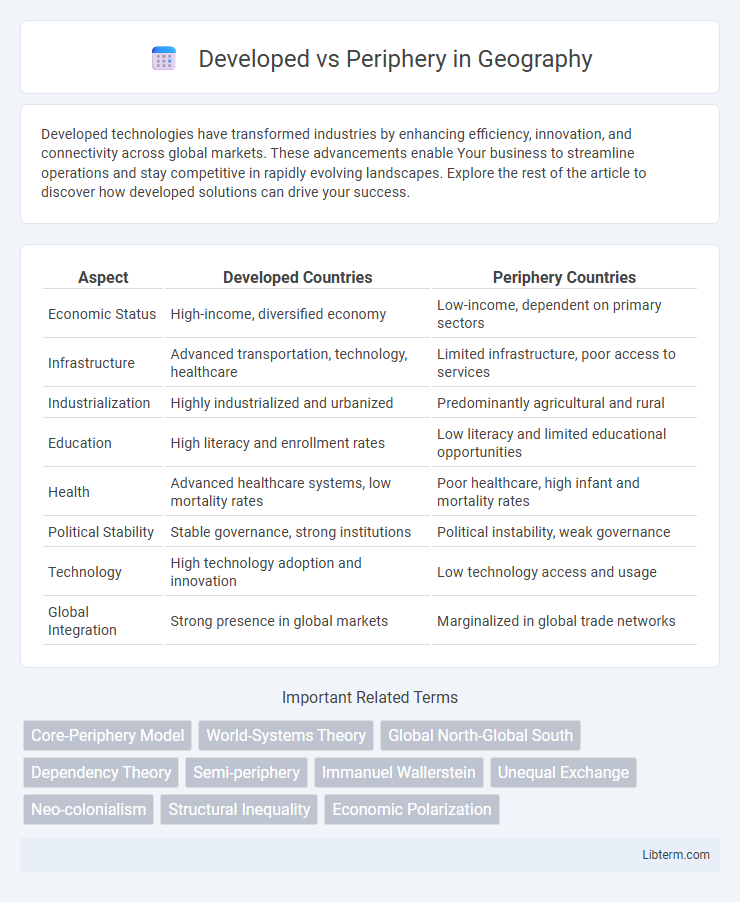Developed technologies have transformed industries by enhancing efficiency, innovation, and connectivity across global markets. These advancements enable Your business to streamline operations and stay competitive in rapidly evolving landscapes. Explore the rest of the article to discover how developed solutions can drive your success.
Table of Comparison
| Aspect | Developed Countries | Periphery Countries |
|---|---|---|
| Economic Status | High-income, diversified economy | Low-income, dependent on primary sectors |
| Infrastructure | Advanced transportation, technology, healthcare | Limited infrastructure, poor access to services |
| Industrialization | Highly industrialized and urbanized | Predominantly agricultural and rural |
| Education | High literacy and enrollment rates | Low literacy and limited educational opportunities |
| Health | Advanced healthcare systems, low mortality rates | Poor healthcare, high infant and mortality rates |
| Political Stability | Stable governance, strong institutions | Political instability, weak governance |
| Technology | High technology adoption and innovation | Low technology access and usage |
| Global Integration | Strong presence in global markets | Marginalized in global trade networks |
Introduction to Developed and Periphery Regions
Developed regions exhibit advanced infrastructure, high GDP per capita, and diversified economies centered around technology and services. Periphery regions often face economic challenges with reliance on agriculture, limited industrialization, and lower standards of living. Understanding these disparities is crucial for addressing global inequality and fostering sustainable development strategies.
Defining Developed and Periphery Economies
Developed economies are characterized by high income levels, advanced technological infrastructure, diversified industries, and strong institutional frameworks that foster economic stability and growth. Periphery economies typically exhibit lower income levels, dependence on primary commodities or limited industrial sectors, weaker governance structures, and higher vulnerability to external economic shocks. The disparity between developed and periphery economies highlights uneven resource distribution, differing stages of industrialization, and varying access to global economic networks.
Historical Roots of Global Inequality
Historical roots of global inequality trace back to colonialism and imperialism, where developed countries exploited periphery regions for resources and labor. The extraction of wealth and establishment of unequal trade relations entrenched economic disparities between the Global North and South. These systemic imbalances continue to influence development trajectories and global power dynamics today.
Key Economic Indicators: Developed vs Periphery
Developed economies exhibit higher GDP per capita, advanced infrastructure, and robust financial markets compared to the periphery, which often faces lower income levels, weaker industrial bases, and limited access to capital. Key economic indicators such as unemployment rates, inflation stability, and trade balances consistently favor developed regions, reflecting stronger economic resilience and diversification. Investment in technology and human capital in developed countries further drives productivity growth, while periphery economies frequently struggle with structural deficits and dependency on primary exports.
Social and Cultural Differences
Developed regions exhibit higher levels of social infrastructure, including advanced education systems and healthcare, which contribute to greater social mobility and cultural diversity. In contrast, peripheral areas often face challenges such as limited access to quality education and healthcare services, reinforcing traditional social structures and slower cultural evolution. These disparities result in varying cultural expressions, social norms, and community dynamics that are closely linked to economic development levels.
Impact of Globalization on Both Regions
Globalization accelerates economic growth in developed regions by enhancing technological innovation, expanding markets, and increasing capital flows. Periphery regions experience mixed impacts, gaining access to global markets and foreign investment but often facing exploitation of resources and labor. These disparities widen the development gap, reinforcing uneven economic integration and social inequalities between the developed core and the periphery.
Trade Relations and Economic Dependency
Developed countries maintain diverse trade relations, exporting high-value manufactured goods and technology while importing raw materials and low-cost products from periphery nations. Periphery countries often exhibit economic dependency on developed states due to their reliance on exporting primary commodities and limited industrial diversification. This asymmetrical trade dynamic reinforces global economic inequalities and hinders sustainable development in peripheral economies.
Technological Advancement and Innovation Gaps
Developed regions exhibit significant technological advancement characterized by high investment in research and development, widespread access to cutting-edge technologies, and robust innovation ecosystems. In contrast, peripheral areas face innovation gaps due to limited infrastructure, inadequate funding, and lower human capital expertise, which hinders their ability to adopt and develop new technologies. This disparity contributes to sustained economic inequalities and restricts peripheral regions from fully participating in global technological progress.
Challenges and Opportunities for Periphery Countries
Periphery countries face significant challenges including limited infrastructure, lower levels of industrialization, and dependency on primary commodity exports, which hinder economic growth and social development. Opportunities arise from increased access to global markets through trade agreements, technological adoption, and targeted foreign investments that can stimulate diversification and enhance productivity. Strategic policies focusing on education, innovation, and sustainable resource management are critical to overcoming structural disadvantages and leveraging potential competitive advantages in niche markets.
Future Trends: Bridging the Development Divide
Future trends emphasize bridging the development divide between developed and periphery regions through digital innovation and sustainable infrastructure investments. Increased adoption of renewable energy technologies and improved access to high-speed internet are key drivers enabling economic growth and social inclusion in peripheral areas. Strategic international cooperation and tailored policy frameworks will play crucial roles in fostering balanced development and reducing global inequalities.
Developed Infographic

 libterm.com
libterm.com